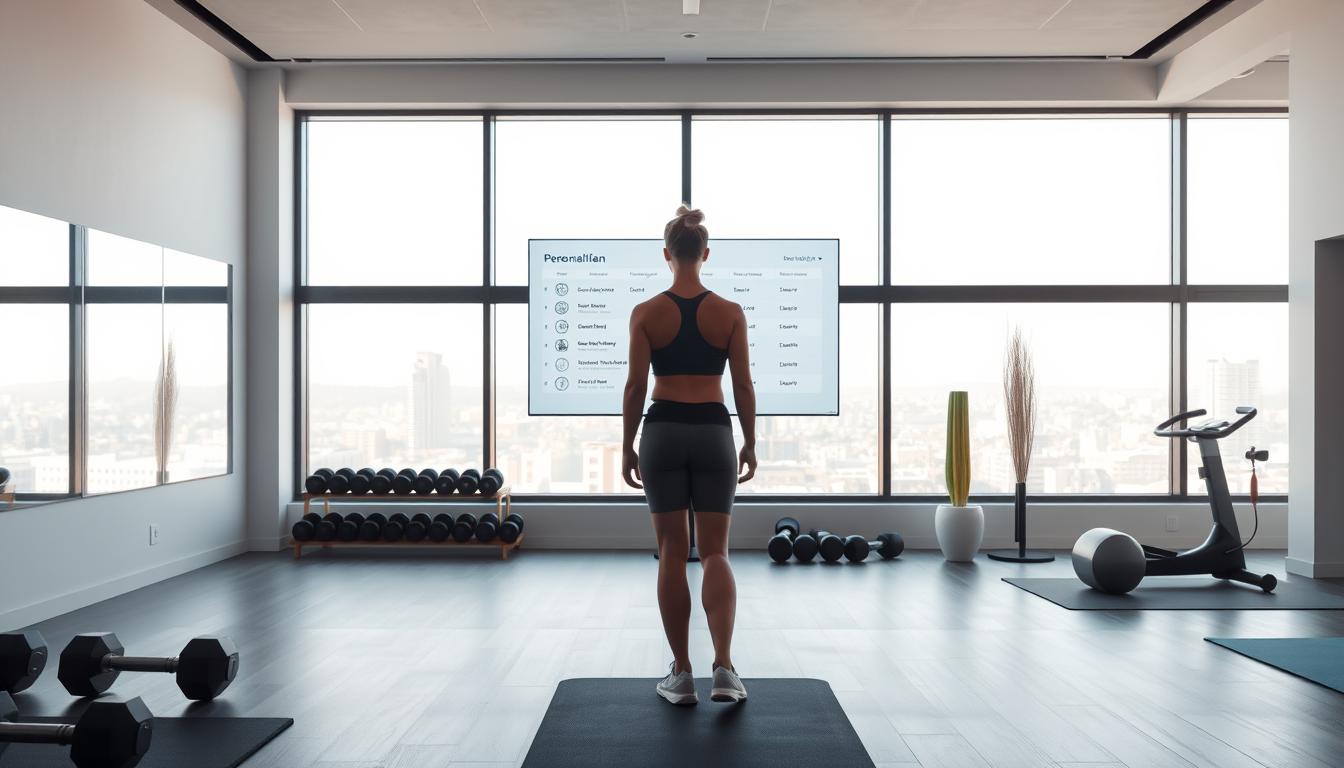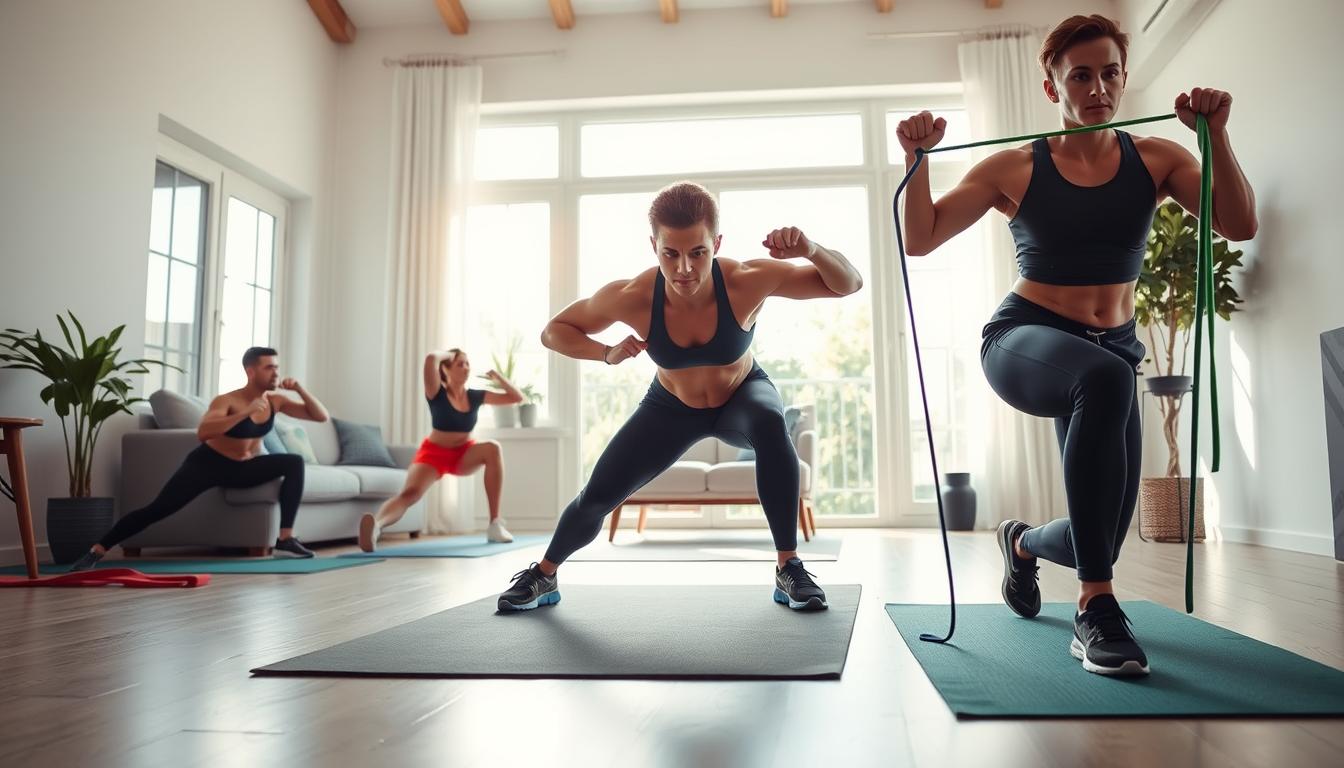Using
AI to create a personalized fitness plan has become more popular. Now, thanks to technology, you can get a
fitness routine made just for you. It meets your specific needs and goals.
In this article, we’ll look at using AI to make a
personalized fitness plan for a week. We’ll share what we learned and how well it worked for reaching fitness goals.
AI in fitness planning is a great option for those wanting a custom
workout plan. It uses data to make a plan that helps you reach your fitness goals faster.
Key Takeaways
- Understanding the role of AI in creating personalized fitness plans
- Exploring the benefits of using AI for a fitness routine
- Insights into the effectiveness of AI-designed fitness plans
- What to expect when using AI for fitness planning
- Potential outcomes of a week-long AI-designed fitness plan
The Fitness Experiment: Why I Turned to AI
I was frustrated with my
fitness journey. I had always loved working out but was stuck. Trying the same routines over and over didn’t give me the results I wanted.
My Previous Fitness Struggles
My
fitness journey was long and hard. I had ups and downs, always looking for the next big thing. But nothing seemed to work for long.
I tried many different workout plans. But none of them fit me right. I needed something that was made just for me.

The Appeal of AI-Generated Fitness Plans
The idea of
AI-generated fitness plans really caught my eye. A plan made just for me sounded amazing. I thought AI could make a
workout plan that would really help me.
AI plans seemed smarter and more flexible than old methods. I hoped AI could do better than human trainers, giving me a plan that was truly mine.
Selecting the Right AI Fitness Tool
Choosing the right AI fitness tool is now a big challenge with so many options. I found that understanding the different types of AI fitness tools is key. It’s important to know their features and benefits.
Popular AI Fitness Applications in 2023
In 2023, many AI
fitness apps emerged, each promising
personalized workout plans and
AI workout routines. These apps, like AI fitness coaches, create
customized fitness plans based on your goals and fitness level.

These apps have cool features like
AI-driven workout planning, tracking your progress, and
real-time feedback. With so many options, it’s vital to focus on the
key features and compare
free vs. premium AI fitness options.
Free vs. Premium AI Fitness Options
Choosing between free and premium AI fitness tools depends on what you need. Free versions offer basic functions, while premium subscriptions give you more advanced features like
detailed workout analytics and
priority customer support.
- Free versions: Basic functionality, limited personalization.
- Premium versions: Advanced features, detailed analytics, priority support.
Features That Matter Most
When looking at AI fitness tools, some features are more important than others. Key features include
creating customized workout plans,
tracking progress, and
real-time motivation. It’s also important to have
AI-driven workout planning that can adjust to your feedback.
- Customized workout plans.
- Progress tracking.
- Real-time motivation.
My Selection Criteria and Final Choice
I looked for an app that understood my
specific fitness goals, was easy to use, and offered
personalization. After trying out several apps, I chose one that met my criteria and had a
user-friendly interface and
robust customer support.
My choice was influenced by the app’s
AI fitness coach abilities, its ability to
adapt to my fitness level, and the quality of
AI workout plans it provided. This process showed how important it is to
evaluate AI fitness apps based on your needs and preferences.
Setting Up My AI Fitness Profile
Starting my
AI fitness plan began with setting up a profile. It included physical and fitness metrics. This step was key for the AI to understand my fitness level, goals, and preferences.
Information the AI Requested
The AI asked for a lot of information to create a
personalized fitness plan. This included:
- Physical metrics like age, weight, height, and body fat percentage.
- Fitness history, including past workouts and any health conditions.
- Goals, like losing weight, gaining muscle, or improving endurance.
- Preferences, such as where to work out (home, gym, outdoors) and what equipment is available.
Physical Metrics and Fitness History
I had to share my physical metrics. This included my age (32), weight (154 lbs), height (5’9″), and body fat percentage (18%). I also shared my fitness history, including past workouts and occasional gym visits.
| Metric |
Value |
| Age |
32 |
| Weight |
154 lbs |
| Height |
5’9″ |
| Body Fat Percentage |
18% |
Goals and Preferences
My main goal was to
enhance endurance and lower body fat. I also had to share my workout preferences, like equipment and times.
How Detailed Was the Input Process?
The input process was very detailed. It needed a full view of my fitness status and goals. The AI tool used this info to create a
fitness plan just for me.
I Tried Letting AI Create My Fitness Routine for a Week: Here’s What Happened
I started a week-long experiment with an
AI fitness plan. The plan was detailed, covering workouts, nutrition, and rest. It was both exciting and a bit too much.
The Initial Plan Reveal
The AI’s
fitness routine was thorough. It had a mix of strength and cardio days. The exercises were both familiar and new, making it fun and challenging.
Workout Structure and Exercise Selection
The AI picked exercises based on what I wanted. It focused on big movements like squats and bench press. The plan aimed to keep getting better with each workout.
Nutrition and Recovery Recommendations
The plan also included nutrition tips for balanced eating and staying hydrated. It suggested ways to recover, like foam rolling and stretching. It showed how important rest is for fitness.
My First Impressions
I was amazed by the plan’s detail at first. The AI really tailored it to me. But, I worried about getting too tired and needing to make changes.
Looking at the plan, I saw it covered all bases of fitness. It had workouts, nutrition, and rest tips. This showed the AI’s skill in making good fitness plans.
Day-by-Day Breakdown: Following the AI Plan
The AI took over my
fitness routine, and I was excited to see the results. I was curious about how my body would react to the AI’s plan.
Days 1-2: The Adjustment Period
The first two days were key. They set the stage for the rest of the week. The AI’s plan was tough but doable, with a mix of cardio, strength, and flexibility.
Initial Challenges and Surprises
The first days were tough, adjusting to the
AI workout intensity and
recovery times. At times, the routine felt
too strenuous. But, the AI’s logic became clearer as the days went by.
How My Body Responded
My body adapted well to the
fitness routine in the first days. My energy levels were a bit off, but the
recovery periods helped even them out.
Days 3-5: Finding My Rhythm
By the third day, the routine felt more natural. The AI had tweaked the
fitness routine to fit my abilities better.
Adaptations and Modifications
The AI kept adjusting the workout, changing its intensity and volume. These
adaptations kept the routine interesting and effective.
Energy Levels and Recovery
I noticed a big boost in
energy levels and
recovery quality. It showed my body was not just getting by but actually benefiting from the routine.
Days 6-7: Final Push and Reflections
The last days were about overcoming fatigue and reflecting. The
AI workout plan pushed my physical limits and showed my mental strength.
By the week’s end, it was clear the AI had created a
fitness routine that was both tough and rewarding. The experience was eye-opening, showing that with the right guidance, amazing results are possible.
Customization and Adaptability of the AI Program
I was eager to see how the AI program would change based on my feedback. It’s key for a
personalized fitness plan to stay relevant and challenging. This is because it learns and adjusts to keep the routine fresh.
The
customization goes beyond just tweaking weights or reps. It’s about knowing how you’re doing and adjusting to your needs. For me, the AI made
mid-week adjustments based on my feedback to improve the fitness plan.
How the AI Responded to My Feedback
When I gave feedback, the AI made big changes to my routine. It
increased the intensity of some exercises and added new ones to keep things interesting. This shows the AI’s
adaptability and ability to keep challenging you.
The AI didn’t just change exercises. It also adjusted
recovery periods and
nutrition advice. This shows it takes a full-body approach to fitness.
Mid-Week Adjustments and Flexibility
The AI’s ability to make
mid-week adjustments was impressive. If I was tired or had a tough workout, it would make the next day’s workout easier. This shows it understands your current state and needs for
flexibility.
This flexibility helped prevent overtraining and kept me moving towards my fitness goals. The AI’s ability to adjust the plan mid-week shows it’s advanced in providing a
personalized fitness experience.
Physical Results and Performance Metrics
Reflecting on my week with an
AI fitness plan, I saw
significant improvements. The data showed clear trends before and after.
Tracking Changes: Before and After
I tracked
strength, endurance, and body composition to see the AI plan’s impact. I started with weight, body fat percentage, and fitness level.
Strength and Endurance Improvements
Following the AI plan for a week, I noticed a
noticeable increase in strength and endurance. My workouts were easier, and I felt more confident.
Body Composition and Recovery Markers
The AI plan also tracked my
body composition. I saw a drop in body fat percentage and better
recovery, like less soreness and quicker healing.
Unexpected Outcomes
One surprise was the
mental toughness I gained. The AI plan boosted my physical health and mental strength.
In conclusion, the results from my AI fitness plan were
overwhelmingly positive. The data and changes prove AI’s value in fitness plans.
Psychological Impact of Following an AI Trainer
Starting my
fitness journey with an AI trainer had a big impact on me. The
AI fitness coach helped me stick to a routine. This routine gave me a sense of
motivation and
accountability.
Motivation and Accountability Factors
The AI’s consistent and data-driven approach boosted my
motivation. It sent me daily reminders and scheduled workouts. This kept me on track. The
accountability was key; the AI watched my progress and adjusted the plan.
The Human Element: What Was Missing?
Even though the AI was good at planning workouts, it missed the human touch. It lacked
emotional support and
real-time feedback.
Emotional Support and Real-Time Feedback
The AI couldn’t offer
emotional support during tough workouts. It could change the workout’s intensity but not provide
emotional encouragement. It also struggled with nuanced, context-dependent feedback.
Community and Social Aspects
The
community and social aspects were missing from the AI experience. Working out with others or having a trainer to share the journey with was something the AI couldn’t offer.
AI vs. Human Trainers: A Critical Comparison
In the world of
fitness coaching, comparing AI plans to human trainers shows interesting facts. Each has its own strengths and weaknesses. It’s clear that both offer unique benefits.
Strengths of AI-Generated Fitness Plans
AI fitness plans have changed how we do workouts. They have two big advantages:
Data Processing and Pattern Recognition
AI can handle huge amounts of data and spot patterns humans might miss. This lets it create fitness plans that really fit an individual’s needs and goals.
Accessibility and Cost-Effectiveness
AI fitness plans are cheaper and easier to get than human training. They offer top-notch fitness advice at a lower cost. This makes quality fitness help more available to everyone.
Where Human Trainers Still Excel
Even with AI’s progress, human trainers still have special skills AI can’t match.
Intuition and Experience-Based Adjustments
Human trainers use their experience and intuition to make changes that AI might not catch. This personal touch is key in making a fitness plan that really fits someone’s needs.
Motivation and Personalized Coaching
Human trainers are also great at motivating people. They offer support, feedback, and encouragement. This helps users stay motivated and stick to their fitness plans.
| Aspect |
AI-Generated Plans |
Human Trainers |
| Data Processing |
Excellent |
Limited |
| Cost-Effectiveness |
High |
Variable |
| Personalized Coaching |
Good |
Excellent |
| Motivational Support |
Limited |
Excellent |
Conclusion: Would I Recommend AI Fitness Planning?
After a week with an AI fitness plan, I learned a lot. The
AI fitness planning gave me a
personalized fitness plan that fit my needs and goals.
AI can make customized workout plans really well. The AI program changed its plan based on what I said and how I did. This level of
personalized fitness is great for those who want a plan just for them.
But, human trainers offer something special too. They give
emotional support and make complex decisions. Whether to use
AI fitness planning depends on what you prefer and need.
If you want a fitness plan that changes with you, try AI. As
AI fitness planning gets better, it will be a big help in fitness. It’s a good
fitness recommendation for many people.
FAQ
What are the benefits of using AI-generated fitness plans?
AI fitness plans are great because they are personalized and efficient. They use lots of data to make workout and nutrition plans just for you.
How do AI fitness tools collect user data?
AI fitness tools get your data through a few ways. They might ask for your physical stats, fitness history, goals, and what you like. This helps them make a fitness plan just for you.
Can AI fitness plans adapt to user feedback?
Yes, many AI fitness programs can change your plan based on what you say. They’re flexible and can adjust to your needs.
How do AI-generated fitness plans compare to human trainers?
AI plans are good at handling data and saving money. But, human trainers are better at understanding you, making adjustments based on experience, and giving personal coaching.
What are the limitations of AI fitness planning?
AI plans might not offer
emotional support or real-time feedback. They also lack the community and social aspects that human trainers provide.
Are AI fitness plans effective for improving physical results?
Yes, AI plans can help improve your strength, endurance, and body shape. They offer a structured and personalized way to get fit.
Can AI fitness plans be used in conjunction with human training?
Yes, using AI plans with human training can be a great combo. It combines the best of both worlds, AI’s data handling and human coaching’s personal touch.
How do I choose the right AI fitness tool for my needs?
To pick the right AI tool, think about what workouts and nutrition plans you want. Also, consider how personalized it is and the cost. Looking at both free and paid options can help you decide.

 These apps have cool features like AI-driven workout planning, tracking your progress, and real-time feedback. With so many options, it’s vital to focus on the key features and compare free vs. premium AI fitness options.
These apps have cool features like AI-driven workout planning, tracking your progress, and real-time feedback. With so many options, it’s vital to focus on the key features and compare free vs. premium AI fitness options.

 These apps have cool features like AI-driven workout planning, tracking your progress, and real-time feedback. With so many options, it’s vital to focus on the key features and compare free vs. premium AI fitness options.
These apps have cool features like AI-driven workout planning, tracking your progress, and real-time feedback. With so many options, it’s vital to focus on the key features and compare free vs. premium AI fitness options.


